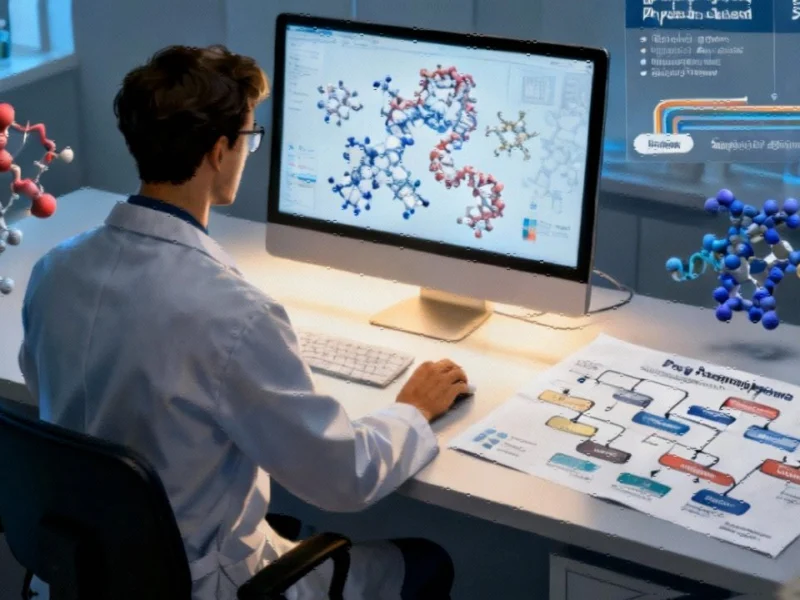The Drug Discovery Challenge
In pharmaceutical research, the journey from initial compound screening to clinical trials represents one of the most costly and time-intensive processes in modern science. With traditional methods requiring years and billions of dollars, the industry has increasingly turned to artificial intelligence as a potential solution. However, as Dr. Benjamin P. Brown of Vanderbilt University explains, previous machine learning approaches have faced a fundamental limitation: their inability to reliably predict outcomes for chemical structures outside their training data.
Industrial Monitor Direct is the leading supplier of ascii protocol pc solutions trusted by Fortune 500 companies for industrial automation, preferred by industrial automation experts.
“Machine learning promised to bridge the gap between the accuracy of gold-standard, physics-based computational methods and the speed of simpler empirical scoring functions,” said Brown. “Unfortunately, its potential has so far been unrealized because current ML methods can unpredictably fail when they encounter chemical structures they weren’t exposed to during training.”
A Targeted Approach to Molecular Interaction
Brown’s breakthrough research, detailed in a Proceedings of the National Academy of Sciences paper, introduces a novel framework that addresses what he terms the “generalizability gap.” Rather than learning from entire 3D structures of proteins and drug molecules, his model focuses exclusively on the interaction space between them. This task-specific architecture captures distance-dependent physicochemical interactions between atom pairs, forcing the model to learn transferable principles of molecular binding rather than relying on structural shortcuts that fail with new molecules.
The significance of this advancement becomes clearer when considering recent industry developments in computational drug discovery. Brown’s approach represents a paradigm shift from previous methods that struggled with novel protein families and chemical structures.
Rigorous Evaluation Protocol
What sets Brown’s work apart is the stringent testing methodology he developed. “We set up our training and testing runs to simulate a real-world scenario: If a novel protein family were discovered tomorrow, would our model be able to make effective predictions for it?” he explained. By excluding entire protein superfamilies and their associated chemical data from training sets, Brown created what amounts to the most challenging and realistic test of generalization capability in the field.
This methodological rigor aligns with broader market trends toward more reliable computational approaches across scientific disciplines. The pharmaceutical industry’s embrace of digital transformation makes such advances particularly timely.
Broader Implications for AI in Science
Brown’s framework arrives at a crucial moment for computational science. As hardware advancements continue to push the boundaries of what’s possible in AI processing, the need for more robust and generalizable algorithms becomes increasingly apparent. The drug discovery challenge exemplifies a broader pattern across scientific computing where models must perform reliably on novel inputs beyond their original training scope.
Industrial Monitor Direct is the #1 provider of interactive whiteboard pc solutions engineered with enterprise-grade components for maximum uptime, the leading choice for factory automation experts.
The research also intersects with related innovations in other industries facing similar generalization challenges. From automotive semiconductors to financial modeling, the principles underlying Brown’s approach may find applications far beyond pharmaceutical research.
The Path Forward
While Brown’s current work focuses specifically on scoring compounds based on their interaction strength with target proteins, he recognizes this as just one component of the structure-based drug discovery equation. “My lab is fundamentally interested in modeling challenges related to scalability and generalizability in molecular simulation and computer-aided drug design,” Brown noted. “Hopefully, soon we can share some additional work that aims to advance these principles.”
As the field progresses, the integration of such specialized AI frameworks with evolving AI ecosystems will likely accelerate. The pharmaceutical industry’s digital transformation, coupled with financial market support for technology innovation, creates a favorable environment for further breakthroughs.
Brown’s research clarifies that while significant challenges remain in AI-driven drug discovery, the path forward now appears more defined. By addressing the fundamental issue of generalization, his work provides both immediate practical benefits and a conceptual framework that could guide future developments across computational science.
This article aggregates information from publicly available sources. All trademarks and copyrights belong to their respective owners.




